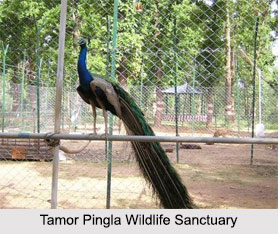 Tamor Pingla Wildlife Sanctuary is located in the Indian state of Chhattisgarh. More specifically, this wildlife sanctuary is located in the district of Surajpur, which borders with the state of Uttar Pradesh. This wildlife sanctuary is named after Tamor hill and Pingla Nalla. The Tamor Hill is a table land rising sharply from the neighboring villages of Tamki, Ghui and Barpetia. This hill is spread over an area of about 250 square kilometers. Tamor hill and Pingla Nalla are considered to be the old and prominent features of the sanctuary area. This wildlife sanctuary has gradually attained popularity, importance and reverence. It has also turned into a revenue earner for the district of Surguja.
Tamor Pingla Wildlife Sanctuary is located in the Indian state of Chhattisgarh. More specifically, this wildlife sanctuary is located in the district of Surajpur, which borders with the state of Uttar Pradesh. This wildlife sanctuary is named after Tamor hill and Pingla Nalla. The Tamor Hill is a table land rising sharply from the neighboring villages of Tamki, Ghui and Barpetia. This hill is spread over an area of about 250 square kilometers. Tamor hill and Pingla Nalla are considered to be the old and prominent features of the sanctuary area. This wildlife sanctuary has gradually attained popularity, importance and reverence. It has also turned into a revenue earner for the district of Surguja.
History of Tamor Pingla Wildlife Sanctuary
Tamor Pingla was notified as a wildlife sanctuary in the year 1978. In the year 2011, this wildlife sanctuary was notified by the Chhattisgarh Government as a part of the Sarguja Jashpur Elephant Reserve.
Geography of Tamor Pingla Wildlife Sanctuary
Tamor Pingla Wildlife Sanctuary is spread over an area of about 608.55 square kilometers (234.96 square miles). The northern boundary of this wildlife sanctuary is formed by the River Moran. Its eastern boundary is formed by the Bonga Nalla and the western boundary is made by the River Rihand. Seven revenue villages are located within the sanctuary namely Khond, Injani, Archoka, Durgain, Kesar, Chattauli and Dhaulpur. These villages are known to be very small with less than 20 households, except Khond.
Flora of Tamor Pingla Wildlife Sanctuary
Tamor Pingla Wildlife Sanctuary is a home to Sal, mixed and bamboo forests. This area falls under Tamor, Khond and Pingla ranges of the Surguja- Jashpur Elephant Reserve Forest Division.
Fauna of Tamor Pingla Wildlife Sanctuary
Tamor Pingla Wildlife Sanctuary provides shelter to animals like barking deer, sambar deer, bear, chital, leopard, elephant, four-horned antelope, tiger, blue bull, bison, chinkara and wild boar.
Threats to Tamor Pingla Wildlife Sanctuary
Decrement in the number of tigers in Tamor Pingla Wildlife Sanctuary was noted in 1990s, owing to negligence from the forest department. From 2003 to 2008, naxal menace also grasped the sanctuary.
Visiting Information
The period between November and June is generally considered to be the best time to plan a tour to Tamor Pingla Wildlife Sanctuary. This sanctuary is located at a distance of about 35 km (22 mi) north of Surajpur and about 94 km from Ambikapur. The nearest railway station to this wildlife sanctuary is Surajpur Railway Station.
Related Articles
Wildlife Sanctuaries of North India
Indian Wildlife Sanctuaries
Indian National Parks
Bird Sanctuaries in India
Indian Wildlife
Conservation of Indian Wildlife











